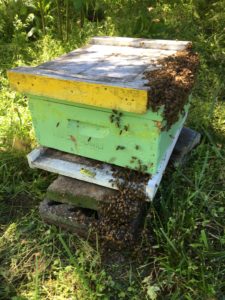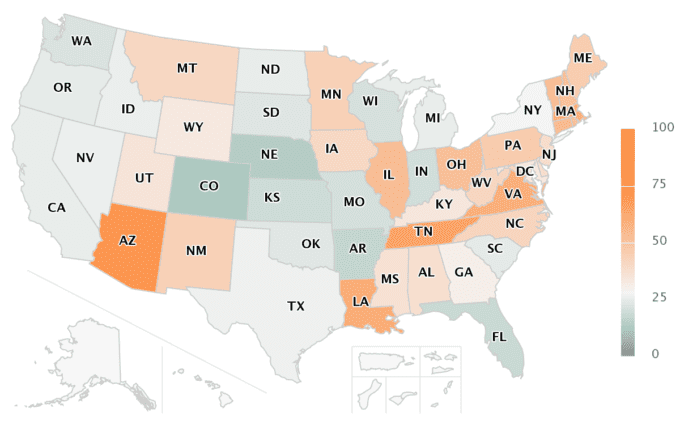The end is near; now hear how we got here!
April is about to end, and with that the Bee Informed National Colony Loss and Management survey will be hibernating (or summering) for another year. If you haven’t participated yet, we kindly ask you to do so here before the survey closes. This is our final advertising push, in the hopes that we can get another bump in participation! We are trying to beat last year’s number of submissions!
It has been an exciting month for the Bee Informed Partnership!
Participation rates of the Survey increased, reached a plateau, then rose again after a bit of PR.… It was like the weather this Spring.
Speaking of spring: This must have been an exciting month for you too since most of you have probably had more than a little peek inside your hives.
Did your bees survive the winter?
For more than a decade, BIP has asked this very question.
A little trivia about the early years of the Survey: Its pre-cursor was conducted collaboratively with the Apiary Inspectors of America in the spring of 2007 via phone. Yes, you read correctly; staff called individual beekeepers to ask about their winter colony losses and diligently recorded their answers.
It was not until 2010 that an online survey was created to annually conduct a loss survey to obtain baseline information of colony mortality. And for the first time, in 2011, BIP lead the effort to begin collecting loss AND management data.
Today the survey is so much more!
Knowing that colonies don’t just die in the winter, we now also calculate summer and annual losses. The survey officially consists of three parts: 1. Colony Losses, 2. Beekeeper Management, and 3. Socio-Economics.
Over the past 13 years, the survey has received more than 50,000 responses! The majority of these come from Backyard beekeepers but we always try to increase the number of sideline and commercial beekeepers with the hope of gathering a representative surveillance of all types of operations. This doesn’t mean that 50,000 unique beekeepers answered the survey; some participants re-visit the survey every year (thank you for your loyalty!!!), whereas others come and go. Although we do not know the identity of our participants, we do know that beekeepers from every state took the survey at some point in the history of the survey.
Although the survey is open for the entire month of April, preparations for it start many months prior.
Some of us begin the year with new resolutions. For BIP, January marks first preparations for the upcoming survey: we update the design, and include comments from previous participants (as much as we can). We then revise the first draft, test the online survey, revise the 2nd draft, re-test the online survey, and so on. It’s definitely a work in progress!
Apart from that, we eagerly write advertisements for the Survey that will run in major beekeeping journals, as well as on our website and Facebook page. If you would like to receive personal reminders in the future, including the link to the online survey as soon as it opens, please sing up here.
On April 1st, we start crossing our fingers. The online portal opens and by now, we have sent out about a 1,000 paper copies of the survey to participants of other surveillance programs such as the Sentinel Apiary Program or BIP’s Technical Transfer teams. From here, the survey is in your hands, beekeepers of America. Well, not exclusively. Throughout April, our E-mail support team is on alert to answer your questions and help you out with any questions that you may have.
May 1st is a sprint. As soon as the survey closes (April 30th), we run the numbers to use in our press release, which is shared with the media and our many stakeholders. Anyone can read our previous press releases too. Be aware that the listed numbers are not definitive. Our mailbox might receive some more paper surveys throughout May, which someone has to add to the database. Anybody who took the survey knows, this can take a while. But by the end of June, we analyze the data one last time and produce an updated state-specific map of colony mortality.

From there, the fun starts for our graduate students. They will spend several months slicing apart the data, analyzing, writing, and editing to prepare a peer-reviewed publication for one of the honey bee research journals as well as presentation material so that we can communicate results to beekeepers across the country.
Ultimately, the Survey allows us to study how beekeeper management and socio-economic factors possibly influence colony mortality. Beekeepers take note. Researchers take note. Policy makers take note, of the Survey. This is your chance to highlight the state of the industry!
Long story short: The Survey is a complex affair that wouldn’t happen without the dedication of many individuals, all of whom we greatly appreciate. And of course, it wouldn’t happen without you!
SURVEY LINK: https://26.selectsurvey.net/beeinformed/TakeSurvey.aspx?SurveyID=LMS2019